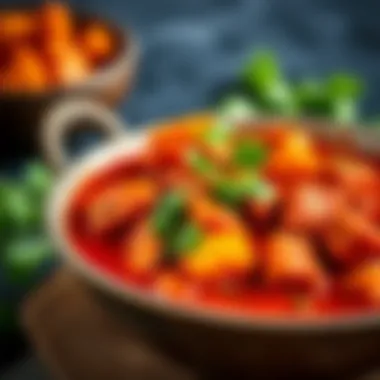Mastering Tikka Masala: A Culinary Journey


Intro
Tikka Masala is more than just a dish; it's a culinary sensation that has made a name for itself around the globe. Its origins are often debated, with some tracing it back to the Indian subcontinent while others argue for its British roots. Whatever its beginnings, one fact remains—Tikka Masala brings a delightful medley of flavors to the table, showcasing what many consider to be the best of Indian cuisine.
In this article, we will journey through the essence of Tikka Masala, breaking down its components and preparation methods. Home cooks will find practical guidance that paves the way for mastering this dish, elevating their culinary repertoire to new heights. The iconic flavors of marinated chicken, aromatic spices, and a creamy tomato sauce will soon feel accessible, thanks to this comprehensive exploration.
As we dive into the specifics, readers will not only gain insight into the essential ingredients needed for an authentic Tikka Masala but also learn about variations that can be tailored to individual tastes. Along the way, we'll throw in tips on how to achieve the perfect balance of spices, along with serving suggestions that will make your meal resonate with flavor and aesthetic appeal.
By the end, fans of Indian cuisine and aspiring chefs alike will have the knowledge to create a dish that is beloved not just for its taste, but also for the rich cultural history it embodies. Let's embark on this culinary adventure together!
Prelims to Tikka Masala
Tikka Masala is not just a dish; it’s a window into a rich culinary heritage steeped in history and cultural nuances. This introduction sets the stage for understanding the multifaceted nature of Tikka Masala, from its origins to its rise as a staple in global cuisine. Within these paragraphs, we will explore how this beloved dish serves as a cultural touchstone in both Indian communities and beyond, while also uncovering the elements that make it a favored option for food enthusiasts worldwide.
Cultural Significance
The cultural significance of Tikka Masala mirrors the intricate threads of history woven across regions and peoples. It's often said that food is a reflection of a society's culture and values; in the case of Tikka Masala, this is particularly true. Originally believed to have roots in Punjabi cuisine, Tikka Masala represents the melding of flavors and cooking techniques from various cultures. Many attribute its proliferation to the diaspora, particularly to the United Kingdom, where Indian immigrants introduced their culinary traditions. As a result, Tikka Masala transcended borders, evolving into a dish that represents not just Indian cuisine, but a celebration of multiculturalism.
Not limited to Indian culture alone, the dish also serves as a culinary bridge. Consider how Tikka Masala has become an interactive experience at homes and restaurants, bringing together diverse communities. When people gather around a pot of Tikka Masala, it fosters connection—be it through shared stories, laughter, or the collective enjoyment of rich flavors. This communal aspect of sharing a meal is timeless and significant, providing warmth and a sense of belonging.
Global Popularity
Tikka Masala's journey across the globe exemplifies the ever-changing dynamics of food culture. The dish has gained unprecedented popularity, particularly in English-speaking countries, where it has sculpted menus in restaurants and cafes alike. The appeal lies in its rich, creamy sauce and diverse adaptability.
In 2001, then British Interior Minister, Robin Cook, famously referred to Tikka Masala as "a true British national dish," which only solidified its status. This whimsical elevation reflects how food can take on identities of its own, reshaping cultural narratives. Beyond the UK, this dish has found favor across Europe, Australia, and North America, resonating with countless palates.
Many food lovers from various backgrounds enjoy Tikka Masala; be it as a comforting family dinner or a delightful indulgence at a restaurant. The versatility in its preparation—from slow-cooked stews to quick meals adapted for busy lifestyles—has made it a go-to choice for many. It’s no wonder that Tikka Masala is frequently found on the dining tables of kitchens all around the world, a culinary passport that invites everyone to partake in the experience.
As we delve deeper into this article, we will further explore the core ingredients that characterize Tikka Masala, revealing techniques for its preparation and unique serving suggestions. This exploration extends beyond mere cooking; it is about relishing the appreciation of flavors that have stitched a narrative spanning continents.
Key Ingredients
The true heart of any delicious Tikka Masala lies in the quality and character of its key ingredients. These components not only add flavor, but also contribute to the dish's overall experience, making it a favorite among food lovers. Delving into the specific elements, their benefits, and considerations around each is essential for creating a successful and memorable Tikka Masala.
Meat Choices
When it comes to selecting the meat for your Tikka Masala, the traditional choice tends to be chicken. However, the world of Tikka Masala is much broader than solely poultry. You can opt for tender lamb, succulent beef, or even juicy prawns, each bringing its own unique flavor profile. For instance, chicken tends to absorb spices well, resulting in a more pronounced taste, while beef offers a richer, heartier experience that some might crave. If opting for lamb, be prepared for a gamey flavor that beautifully complements the robust seasonings.
Furthermore, it's essential to consider marination. Allowing the meat to soak in yogurt and spices not only tenderizes it but also infuses it with layers of flavor. This process can take several hours, or even overnight, and is a worthwhile step for any home chef aiming to create the perfect Tikka Masala.
Spices and Seasonings
At the core of Tikka Masala's rich flavor is a carefully curated blend of spices. While the exact mix may vary from one region to another, there are some essentials that are commonly found in most recipes. For instance:
- Cumin – adds an earthy warmth
- Coriander – imparts a hint of citrus
- Garam masala – a quintessential blend that brings depth
- Turmeric – provides vibrant color and health benefits
The balance of these spices is crucial. Too much heat from chilies could overshadow other flavors, while not enough could leave the dish flat. The trick is to find harmony in the seasonings, creating a depth that excites the palate without overwhelming it. For many, this balancing act is a dance of creativity; a pinch here or a dash there can elevate your dish from ordinary to extraordinary.
"Cooking is like love; it should be entered into with abandon or not at all."
Vegetarian Variations
Tikka Masala doesn't have to mean meat. There are splendid vegetarian variations that can rival the traditional recipes. For example, substituting meat with paneer, a mild cheese, is a beloved option. Paneer absorbs flavors beautifully and retains its shape, making it an excellent candidate for this dish. Alternatively, stewed chickpeas or grilled vegetables like bell peppers, cauliflower, and zucchini also make for hearty vegan options.
When going meatless, the marination process may still be beneficial for enhancing flavor. Using a similar yogurt-based marinade infused with spices can yield satisfying results. Embracing various protein sources leads to culinary innovations that can cater to diverse dietary preferences while visiting the captivating world of Tikka Masala.
Preparation Techniques
Preparation techniques play a crucial role in achieving the perfect tikka masala. Proper methods in marination and cooking can significantly influence the dish’s flavor, tenderness, and overall eating experience. By understanding the process from start to finish, one can truly bring out the best flavors within the ingredients, ensuring that each bite bursts with authenticity and richness.
Marination Process
The marination process is where the journey to flavorful tikka masala begins. This step is not just about adding spices to the meat; it’s about infusing it with flavor. By marinating chicken, lamb, or shrimp in a mixture of yogurt and spices such as cumin, coriander, and turmeric, the proteins tenderize while absorbing the rich and aromatic qualities of these ingredients. Ideally, aim for a marination period of at least three hours or, even better, overnight.
The thick yogurt not only lends a subtle tang but also acts as a tenderizer, making the meat succulent and juicy. It’s in this phase where the magic truly happens—the flavors meld and integrate, setting the stage for a delightful dish. Don't overlook the importance of a well-executed marination; skipping this step could lead to a one-dimensional taste that misses the mark.


Cooking Methods
When it comes to cooking tikka masala, there are several methods to consider, each with its own unique characteristics and advantages. The choice of cooking method can alter the taste, texture, and even the aesthetics of the final dish.
Grilling
Grilling tikka masala is a popular method celebrated for its ability to introduce a smoky flavor, which adds depth to the dish. The high heat of the grill causes the meat to develop a charred, crispy exterior, while the inside remains juicy. This method not only enhances the flavor profile but also contributes a visual appeal that makes the dish inviting.
However, grilling can be tricky; maintaining the right temperature is crucial to prevent charring or undercooking. Keep a close eye, as the delicate balance can make or break the dish. The result, though, is a vibrant and aromatic piece of tikka that sets the tone for the entire meal.
Baking
Baking is another effective method that provides consistent heat for cooking the tikka pieces. With this approach, one can easily prepare larger quantities, making it an ideal choice for gatherings or family meals. While baking may not produce the same smoky flavor associated with grilling, it does allow for a gentle cooking process that keeps the meat tender.
A unique feature of baking is the ability to layer flavors. By placing the marinated meat in a sauce during the baking process, you ensure that the flavors meld beautifully. The downside? It requires a longer cooking time compared to grilling, but patience pays off with thoroughly cooked, flavorful pieces of tikka.
Stovetop
Cooking tikka masala on the stovetop is perhaps the most accessible method for home cooks, requiring just a pan and a bit of oil. This method allows for excellent control over the cooking temperature, ensuring the meat doesn’t dry out or become tough. Additionally, a stovetop provides convenience since there’s no need for specialized equipment.
The key characteristic of stovetop cooking lies in the immediacy of adding spices and other elements to the pan, enabling one to adjust flavors on the fly. It also permits the use of a single pot for marinating and cooking, leading to less cleanup afterward. However, the unique aspect here is the method's potential for uneven cooking if a proper flame isn't maintained. Yet, when done right, it can yield a warm and comforting dish that’s perfect for sharing.
"Your cooking is only as good as the techniques you master. Any method can be delightful when you pay attention to the details."
There's no ‘one-size-fits-all’ choice when it comes to cooking methods. By understanding the unique contributions of grilling, baking, and stovetop preparation, cooks can select the techniques that best suit their preference and situation. Each method comes with its advantages and considerations, but it's the hands-on experience that ultimately paves the way to crafting a stellar tikka masala.
Base Sauce Creation
A well-crafted base sauce is the heart and soul of any tikka masala, serving as the canvas upon which flavors are built. This component shapes not only the texture but also the depth of flavor in the dish. Many cooks might overlook this crucial stage, but creating a robust base sauce is essentially what distinguishes a mediocre dish from a spectacular one. The sauce brings together various ingredients harmoniously, allowing the spices and the marinated meat to shine. When prepared correctly, the base sauce can enhance, elevate, and even transform the overall experience of enjoying tikka masala.
Choosing Base Ingredients
Selecting the right base ingredients is pivotal to crafting a flavorful tikka masala sauce. Unlike a standard tomato sauce, the tikka masala base entails a thoughtful choice of components. Tomatoes are often the star, delivering acidity and a natural sweetness. Canned tomatoes, particularly the varieties labeled as whole or crushed, are typically favored because they offer a consistent flavor profile and a richer texture.
Onions play a crucial role, too. They add sweetness and depth, contributing to the overall body of the sauce. Opt for yellow or white onions, as they caramelize exceptionally well, imparting a nice golden hue and a pleasant complexity.
Finally, a good quality cream or yogurt can be essential for achieving that velvety texture that so many associate with the dish. For a lighter option, using coconut milk can impart a different yet delightful flavor.
Here's a simple list of base ingredients:
- Tomatoes (canned or fresh)
- Onions (yellow or white)
- Garlic and ginger (for flavor enhancement)
- Cream or yogurt (for richness)
- Cooking oil (for sautéing)
In addition to these elements, many cooks add stock or broth to create a nice balance and depth; chicken or vegetable stocks work well.
Balancing Flavors
Creating a sauce is much like composing a song; every element must work together to achieve harmony. Balancing flavors is where the art comes into play. After combining the primary ingredients, the next step is seasoning. This is where your spices shine, but control is vital.
Start with foundational spices such as cumin, coriander, and garam masala. These should be added at the right moments during cooking to coax out their flavor without overwhelming the dish. For instance, toasting the spices briefly in oil before adding the base ingredients can significantly enhance their fragrance and potency.
Don't forget about acidity; a splash of lemon juice or a hint of vinegar can brighten up the sauce. Salt, of course, plays a dual role, accentuating flavors while also offering essential balance.
A popular method to ensure proper flavor integration is to adjust seasonings gradually, tasting as you go. Always remember, the goal is to create a well-rounded sauce where no single flavor dominates. Too much spice may overshadow the dish’s uniqueness, just as leading too heavily on cream can stifle the vibrant notes of the tomatoes.
The balance of flavors is essential; it's not just about adding ingredients, it’s about creating a cohesive experience.
In summary, a carefully constructed base sauce is vital for an authentic tikka masala. By selecting quality ingredients and mastering the art of flavor balancing, any home cook can elevate their culinary skills and create a dish that resonates with the spirit of traditional Indian cuisine.
Step-by-Step Recipe
When it comes to mastering tikka masala, following a precise, step-by-step recipe is crucial. Not only does this methodical approach keep the kitchen chaos at bay, but it also unpacks the complexities of flavors that make this dish a favorite for many. By dissecting the process into manageable segments, home cooks can pay close attention to details—ensuring that every bite is nothing short of perfection. Let's explore the various steps you need to take to make a delightful tikka masala that can impress any palate.
Marinating the Meat
Marinating is the foundation of a flavor-packed tikka masala. It serves as the first layer of taste where the meat absorbs spices, yogurt, and other ingredients that enhance its juiciness and tenderness. Typically, chicken is the star of the show, but that doesn’t mean you can’t use lamb or even paneer for vegetarian versions!
- Choose Your Marinade Wisely: A good marinade often includes yogurt, which helps tenderize meat and infuses it with flavor from spices like cumin, coriander, and garam masala.
- Timing is Key: Allow the meat to marinate for at least one hour, but for the best results, let it sit overnight in the refrigerator. This way, the flavors permeate deeply.
- Consistent Coating: Ensure that every piece of meat is evenly coated in the marinade. You don’t want some bites to be bland when others are bursting with flavor.


> "The longer you marinate, the richer and more profound the taste becomes, transforming an ordinary meal into something extraordinary."
Cooking the Tikka
Once marination is complete, the next step is cooking the meat itself, which brings it to life and gives it that signature char and smoky flavor. You essentially have three main methods to choose from:
- Grilling: Ideal for an authentic smoky flavor. Preheat your grill, cook the marinated pieces until they're charred and cooked through.
- Baking: A convenient alternative, especially if you’re cooking for a crowd. Place the marinated pieces on a baking sheet and bake at a high temperature until fully cooked.
- Stovetop: If you’re tight on time or space, skillet cooking can yield delicious results. Use a little oil to sear the pieces, ensuring a golden crust forms.
Regardless of your chosen method, achieving the right doneness is essential to maintain flavor and avoid dryness.
Preparing the Sauce
With the tikka cooked to perfection, it’s time to dive into preparing the sauce. The sauce for tikka masala is as vital as the meat itself, balancing flavors and providing a creamy texture that compliments the spices from the marinade.
- Base Ingredients: Choose quality tomatoes, preferably fresh or high-quality canned ones, to form the backbone of the sauce. Cook them down until they become rich and concentrated.
- Adding Aromatics: Onions, garlic, and ginger should be sautéed until they’re golden and fragrant before adding to the tomatoes.
- Seasoning: Stir in ground spices like turmeric and chili powder, adjusting to your preference for heat and complexity. Remember, the sauce should sing with flavor; don’t be shy with spices.
Combining and Simmering
After your tikka is perfectly cooked and the sauce is luxuriously rich, it’s time to combine the two. This stage is where all the magic happens:
- Fold Them Together: Gently mix the cooked tikka into the sauce, ensuring every piece is well-coated.
- Simmer with Care: Allow the dish to simmer for about 15-20 minutes. This step helps marry the flavors and deepen the overall taste of the dish.
- Final Touches: A sprinkle of fresh cilantro or a dash of cream can take your tikka masala to new heights. Don’t skip this step, as it adds a touch of freshness and visual appeal.
Taking the time to carefully combine and simmer the meat and sauce ensures that the resultant dish is nothing less than a work of art.
By meticulously working through each stage, you're not just following a recipe; you're creating a harmonious dish that highlights the essence of tikka masala. So take a bow, you’re on your way to serving up something truly special!
Serving Suggestions
When it comes to enjoying tikka masala, serving suggestions play a critical role in enhancing the overall experience. The correct accompaniments elevate the dish, offering not just balance, but also harmony of flavors and textures. Choosing how to serve this beloved dish is not just about filling plates; it's about creating an experience that resonates with the flavors of India, inviting diners to indulge fully.
Accompaniments
Rice
Rice is often considered the bedrock of Indian cuisine, and when paired with tikka masala, it truly shines. The unique characteristic of rice lies in its ability to absorb the rich, spiced gravy, transforming each bite into a comforting experience. Basmati rice, with its long grains and aromatic qualities, stands out as the beloved choice. This particular type of rice not only provides a nutty flavor but also brings a delicate texture, complementing the hearty nature of the masala. Furthermore, its fluffy quality prevents mushiness, helping to maintain a delightful contrast against the creamy sauce.
However, long-cooked rice can sometimes stick together, which might detract from the overall presentation. Nonetheless, when prepared properly, rice remains a staple, making it an indispensable part of the meal.
Naan
Naan bread is another classic accompaniment that deserves mention. Its soft, pillowy structure is perfect for scooping up the delectable tikka masala. The bread’s slightly charred exterior, achieved by being cooked in a tandoor, lends a unique flavor that enhances the dish's depth. Naan is often served with various toppings; garlic naan is a popular variation, which adds a punchy flavor that works in tandem with the spiced chicken or paneer.
While naan is seen as a favorite among diners, it can sometimes overshadow the tikka masala if not balanced well. Additionally, its higher caloric content compared to rice can be a concern for those watching their diet.
Salads
Salads serve as a refreshing counterpoint to the richness of tikka masala. A crisp salad, typically made with cucumbers, tomatoes, and onions, provides crunch and acidity that balances the rich flavors of the dish. These elements contribute not only to taste but also to visual appeal, making the plate look vibrant.
One of the standout features of salads is their versatility; they can be seasoned with lemon juice, yogurt or even a dash of chaat masala for an extra kick. Salads are usually low in calories and high in nutrients, making them an excellent choice for health-conscious diners. However, one must be cautious about the type of dressing used, as overly creamy varieties may negate the health benefits intended.
Presentation Tips
Good presentation serves as both an invitation and an impression. To make the dish appealing, consider using a shallow bowl to serve the tikka masala, allowing the sauce to pool invitingly. Sprinkle chopped cilantro on top for a burst of color, and add a wedge of lemon not just for color but for a zesty lift that balances the flavors. Pairing your dish with accompaniments on side, like a small dish of rice and a piece of naan on a separate plate, provides an organized, aesthetically pleasing setup.
Creating an impressive presentation is about removing clutter and allowing each component to shine—after all, we eat with our eyes first.
"The magic of serving is intertwining taste, appearance, and tradition together, making each meal an unforgettable occasion."
When you marry your tikka masala with these ideal accompaniments and considerations, you invite a culinary experience that is truly holistic and enriching.
Variations of Tikka Masala
The exploration of Tikka Masala is not merely confined to one recipe or style; it opens a door to a plethora of variations that cater to diverse palates and cultural influences. Understanding these variations enriches the overall experience of creating and enjoying this dish. Each variant provides a unique twist that communicates the history, regional ingredients, and personal preferences of the cook.
When it comes to Tikka Masala, one size certainly does not fit all. The ability to adapt the fundamental recipe demonstrates both the versatility and communal appeal of the dish. The variations serve as an invitation for culinary creativity—encouraging cooks to experiment and make the dish their own.
Regional Twists
The heart of Tikka Masala lies in its ability to adapt to local tastes and traditions. Different regions have their own take, which not only reflects their culinary heritage but also introduces unique flavors.


- Punjab: This region is often credited with the origin of Tikka Masala, and here, you might find it featuring extra cream and butter, giving it a rich and indulgent quality.
- Bangladesh: Known locally as Bhuna Masala, it often incorporates fresh green chilies and a more robust flavor profile, pushing the spice envelope just a tad further.
- UK: In British versions, tomato ketchup is sometimes thrown into the mix to suit Western tastes, giving it a sweet tang that's beloved across the UK.
- Malaysia: Tikka Masala often mingles with local flavors like lemongrass and ginger, creating dishes that are both aromatic and extremely satisfying.
These regional twists are what make Masala unique. They are testaments to how a dish can transform and evolve according to its surroundings.
Vegetarian and Vegan Options
In today's culinary landscape, the demand for vegetarian and vegan options is sky-high. Tikka Masala isn't left behind here; it caters to plant-based diets with gusto. Not only do these alternatives retain the essence of the dish, but they also offer an array of health benefits without sacrificing flavor.
For those leaning away from meat:
- Chickpeas: These legumes can stand in for chicken, absorbing the spices beautifully when properly cooked.
- Tofu or Paneer: These protein-packed options are marinated just like meat, adding a delightful texture and flavor.
- Vegetable Medley: Cauliflower, peas, and bell peppers not only add color but also a balance of flavors.
Emphasizing these vegetarian and vegan options isn't just about feeding tastes; it's also a recognition of growing dietary preferences, making Tikka Masala an accessible dish for everyone. This adaptability showcases a broader culinary culture that values inclusivity without compromising on comfort or satisfaction.
Cooking Tips for Enhanced Flavor
When it comes to Tikka Masala, the difference between a good dish and a great one often boils down to a few key cooking tips that can elevate flavors to new heights. Quality ingredients, expert technique, and attention to detail are fundamental in crafting an authentic recipe that resonates with taste. Embracing these tips not only enhances flavor but also enriches the entire cooking experience—transforming it from a mundane routine into an adventure in your kitchen.
Choosing Quality Ingredients
The foundation of Tikka Masala is indeed its ingredients. Using top-notch components can significantly elevate the dish, making a noticeable difference in taste and texture. Begin with fresh produce; vibrant tomatoes, aromatic onion, and crisp garlic are essential. They infuse your dish with flavor that pre-packaged options simply can’t match.
When selecting the meat, opt for responsibly sourced chicken, lamb, or even a combination thereof, if that's your inclination. The texture of the meat becomes tender when marinated properly, absorbing flavors during the cooking process. Be wary of frozen meats, as they can lose moisture and flavor upon thawing.
A home cook's pantry should also be stocked with various spices, and understanding their quality is crucial. Spices like cumin, coriander, and garam masala should be fresh. If they’re stale, they’ll fall flat, lacking the aromatic punch that defines Indian cuisine. If possible, buy whole spices and grind them at home; the fragrance that wafts from the grinder alone is a tangible indicator of quality.
Freshness matters! The zest of a freshly grated ginger can make your dish sing, in contrast to the sandpaper that faded ginger brings.
Inspection of Spices
Inspecting spices extends beyond just noting their age; you also need to check for their aroma and color. Start by taking a whiff. If there’s no smell at all, chances are the spice has lost its potency. Good spices should have a robust fragrance, one that can transport you straight onto the bustling streets of an Indian market.
Color can tell a lot too. Bright, vivid spices are usually the freshest, while those that are dull or faded might not pack the flavor you desire. Pay attention to essential spices like turmeric, paprika, and cayenne; quality seasoning can significantly alter the heat and color of your sauce.
Consider using smaller quantities of spices, purchased at local markets or specialty shops rather than huge jars that you may not use completely. This not only ensures freshness but also allows you to explore various spice profiles for your Tikka Masala.
Finally, store your spices in a cool, dark place away from light and moisture. An airtight container is ideal. This simple act can lead to an extraordinary difference in your cooking outcomes, ensuring that your beloved Tikka Masala reaches its full flavor potential.
Nutritional Considerations
When it comes to enjoying Tikka Masala, nutrition plays a crucial role in how this dish can fit into a balanced diet. Understanding the nutritional aspects not only enhances your cooking experience but also allows you to make informed choices that align with your dietary needs. With a dish like Tikka Masala, which is rich in flavors and textures, it is essential to look closely at the caloric content and the potential for healthier substitutions.
Understanding Caloric Content
The caloric content of Tikka Masala can vary significantly based on the preparation method and the ingredients used. Generally, traditional recipes may find themselves packing a decent caloric punch, primarily due to the creamy sauces and the meat or paneer often included. For instance, a serving might contain anywhere from 300 to 600 calories, depending on the portion size and the amount of oil, cream, or butter utilized in cooking.
To keep tabs on your caloric intake, it can be helpful to break down the ingredients. Consider the following:
- Chicken or other meats: Protein-rich but can contribute large calorie counts when marinades and sauces are added.
- Cream or coconut milk: While they add richness, these ingredients can elevate caloric density quickly.
- Rice or naan: Common accompaniments that also add to the overall calorie count.
By understanding these elements, you gain a better grasp on how to make Tikka Masala an enjoyable yet sensible choice in your meals.
Healthy Substitutes
Making Tikka Masala doesn't mean compromising on health. There are several smart substitutions you can make that not only decrease calories but also add nutritional value. Here are some suggestions:
- Yogurt instead of Cream: Swap out heavy cream with low-fat yogurt for a lighter version that still maintains a creamy texture.
- Cauliflower Rice: Instead of traditional rice, consider using cauliflower rice, which reduces carbohydrates and calories but keeps the meal satisfying.
- Grilled Chicken versus Fried: Opt for grilled chicken over fried to cut back on unhealthy fats while still enjoying the classic flavors.
"Eating well is a form of self-respect. Choose ingredients that uplift your health."
Culmination
Wrapping up the exploration of Tikka Masala, it becomes crystal clear just how important this dish is not merely as a meal, but as a cultural narrative woven into the very fabric of many lives. It highlights more than just a recipe; it embodies generations of tradition, showcasing the way food can connect us across boundaries.
Summarizing the Experience
Through this journey, we have unearthed the richness of flavors that compose Tikka Masala. From the delicate marination process to the careful crafting of the sauce, every step serves as a reminder that cooking is an art form. The blend of spices such as garam masala and cumin, paired with the charred texture of grilled meat or vegetables, creates a symphony on the palate. Whether served with fluffy naan or basmati rice, the experience of Tikka Masala transcends its ingredients, inviting people to gather around the table and share their stories over a satisfying meal.
Encouragement for Experimentation
As we conclude, it’s crucial to encourage readers to dive deep into their own kitchens, crafting their unique variations of this classic dish. Whether you prefer a fiery version with heaps of chili or a milder one suitable for kids, there’s no right or wrong approach. Cooking is about personal expression and adaptation.
Try switching out traditional protein for a twist—maybe go for paneer or even chickpeas in a vegan rendition. The beauty lies in trial and error, and through this, one can cultivate a deeper appreciation for culinary traditions. With this in mind, don’t shy away from experimenting with flavors. Tikka Masala is not just a recipe; it’s an invitation to explore the vast universe of taste and technique.







